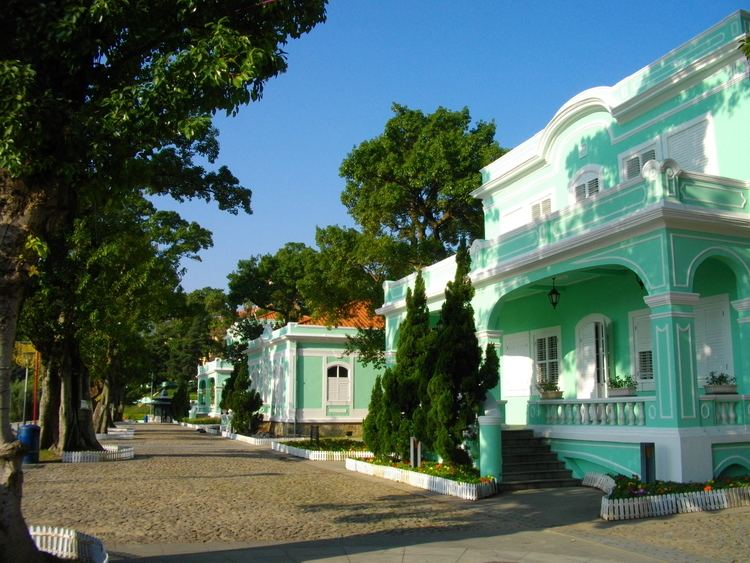Country Macau Area 6.33 km² Province Guangdong Province | Time zone Macau Standard (UTC+8) Population 92,200 (2013) Area code 0 | |
 | ||
Region Municipality of das Ilhas Points of interest Taipa Houses–Museum, Our Lady of Carmel Church, Cidade Das Flores Garden, Garden of Tai Tam Hill, Taipa Central Park | ||
Exploring macau taipa china travel vlog i
Taipa is an island in Macau, presently united by an artificial landfill to the island of Coloane. Administratively, Taipa constitutes a freguesia (civil parish) named Freguesia de Nossa Senhora do Carmo.
Contents
- Exploring macau taipa china travel vlog i
- Map of Taipa Macau
- 2016 taipa village promotional video
- Geography
- The names of Taipa
- Tertiary Educational Institutions
- International schools
- Tourism
- References
Map of Taipa, Macau
2016 taipa village promotional video
Geography
Taipa is 2.5 kilometres (1.6 miles) from Macau Peninsula and east of the Lesser Hengqin Island of Zhuhai, Guangdong Province. Macau International Airport, University of Macau, Macau Jockey Club and Macau Stadium are situated in Taipa.
Most Chinese settlement of Taipa occurred during the Southern Song Dynasty, while the Portuguese occupied the island in 1851. Prior to land reclamation, Taipa consisted of two islands: Greater Taipa and Lesser Taipa.
The 159.1-metre (522.0-foot) Big Taipa Hill (大氹山) is to the east, and Small Taipa Hill (小氹山) to the west. Central Taipa is a plain as a result of siltation and land reclamation. Initially Taipa was connected to Coloane Island only by the Estrada do Istmo (路氹連貫公路); but the area called Cotai, built on reclaimed land from 2004 and which is home to mega-resorts, casinos, and convention and exhibition centers, has now connected the two islands into one piece of land. Taipa is connected to peninsular Macau by Governador Nobre de Carvalho Bridge, Friendship Bridge and the Sai Van Bridge.
Taipa is predominantly a growing residential area with many new apartment complexes, mostly up-scale, under construction as of 2006. As a new town of Macau, Taipa has better city planning than Macau Peninsula; however, many people choose to live in Macau Peninsula since most of the famous schools are located there.
The names of Taipa
In Cantonese, Taipa has been known by many names over time, including 龍環 (Lung Waan, meaning "Dragon Ring"), 雞頸 (Gai Geng, "Chicken's neck"), 潭仔 (Tam Tsai, "Pool"), and 龍頭環 (Lung Tau Waan, "Dragon's-Head Ring").
The Portuguese and English name "Taipa" comes from the Chinese pronunciation of 氹仔 in Min Nan /tiap-á/ (similar to "tiamp-a") then became "Taipa". The putonghua pinyin for 氹仔 is dàngzǎi, and this is how the island is referred to in Mandarin. Both the character 氹 and the alternative form 凼 mean cesspit, but are obsolete in modern Chinese, and only used in relation to Taipa and the Macau-Taipa Bridge (澳氹大桥 àodàng dàqiáo). The character 氹, or 凼, is often missing from mobile phone and computer input systems.
Another version according to legend, comes from an exchange between early Portuguese settlers on Taipa and local Chinese settlers. The Portuguese asked the Chinese the name (nome in Portuguese) of the place. The Chinese settlers were local grocery shopkeepers and spoke no Portuguese, but took the Portuguese nome for the Chinese 糯米, "sticky rice", which is pronounced similar to nome in Cantonese. Thinking the Portuguese settlers were asking if they sold sticky rice, the Chinese responded with "大把," pronounced "daai ba" in Cantonese, meaning "a lot." The Portuguese, hearing the response, took this to be the name of the place. There is, however, no historical evidence to support this story. "Taipa" is also what the Portuguese call the clay-mud, rammed into moulds, used to build mud houses in Portugal in times gone by, in recent times referred to as Rammed Earth.
It is also worth noting that, as the great majority of the population in Taipa and Macau is Chinese, however there is a growing community of expatriates living in Taipa who work at the Casinos on the Cotai Strip. Most people refer to this island by its Cantonese name, "Tamzai", and most taxi drivers and bus drivers will not understand if asked how to go to "Taipa."
